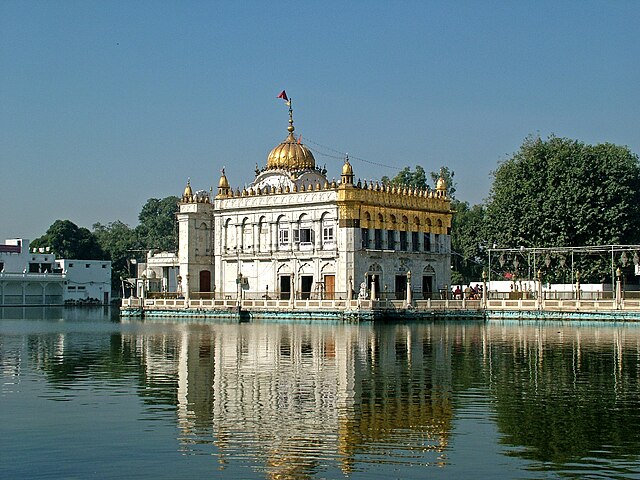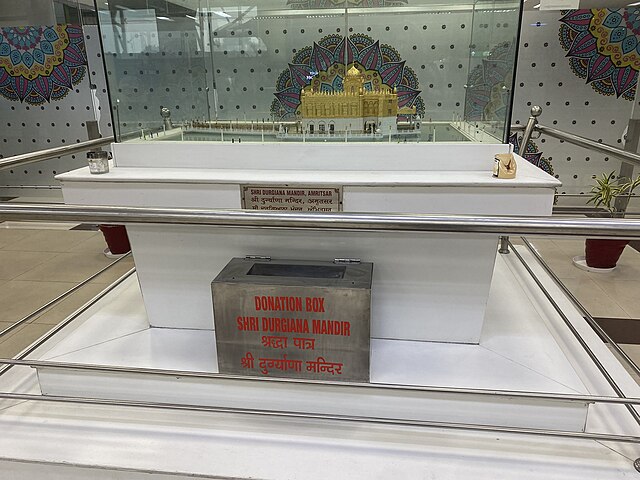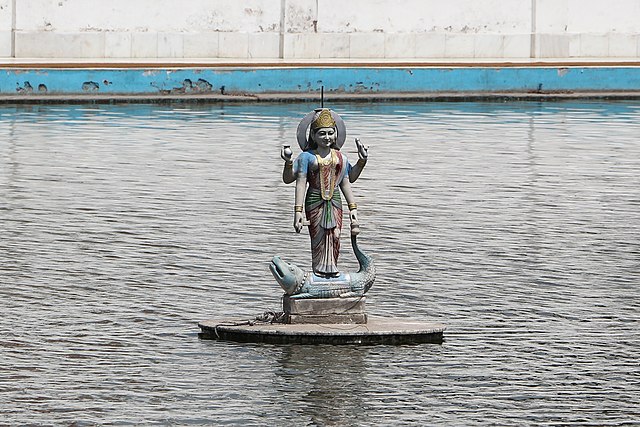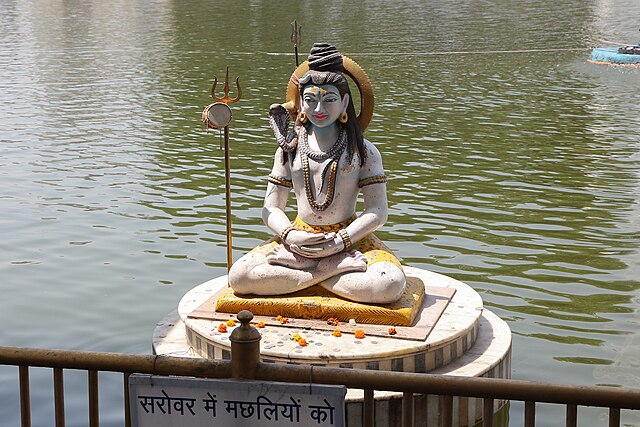Have you ever wondered what makes a temple truly special? Is it the intricate architecture, the spiritual atmosphere, or perhaps the centuries of devotion that have blessed its walls? The Durgiana Temple in Amritsar perfectly embodies all these elements, standing as one of Punjab’s most revered Hindu temples.
Located in the heart of Amritsar, this magnificent temple dedicated to Goddess Durga attracts thousands of devotees and tourists every year. What sets Durgiana Temple apart isn’t just its religious significance – it’s the unique blend of architectural beauty, spiritual energy, and cultural heritage that makes every visit unforgettable.
Often called the “Silver Temple” due to its stunning silver doors and decorative elements, Durgiana Temple represents the perfect harmony between traditional Hindu architecture and modern devotional practices. Whether you’re a spiritual seeker, architecture enthusiast, or curious traveler, this temple offers something extraordinary for everyone.
Historical Background and Origins
The story of Durgiana Temple begins in the early 20th century, though its spiritual roots run much deeper. Built in 1921 by the efforts of local Hindu community leaders, this temple was constructed to serve the growing Hindu population in Amritsar, a city predominantly known for its Sikh heritage and the famous Golden Temple.
The temple’s establishment came during a period of religious and cultural awakening in Punjab. Local philanthropists and religious leaders recognized the need for a grand Hindu temple that could match the architectural grandeur of other religious sites in the city. The construction was funded through community donations and took several years to complete, with artisans from across North India contributing their skills to create this masterpiece.
What makes the temple’s history particularly fascinating is how it seamlessly integrated into Amritsar’s diverse religious landscape. Rather than creating division, Durgiana Temple became a symbol of unity, welcoming people from all backgrounds to experience its divine energy. The temple has witnessed numerous historical events, including the partition of India, and has served as a beacon of hope and faith for countless devotees.
Architectural Marvel of Durgiana Temple

Design Elements and Structure
The architectural brilliance of Durgiana Temple lies in its unique design that combines traditional Hindu temple architecture with distinctive North Indian elements. The temple complex features a stunning amalgamation of domes, spires, and intricate carvings that create a visual feast for visitors.
The main temple structure follows the traditional Hindu architectural style known as Nagara, characterized by its tower-like spires called shikharas. These spires are adorned with elaborate carvings depicting various Hindu deities and mythological scenes. The temple’s layout follows the principles of Vastu Shastra, ensuring positive energy flow throughout the complex.
One of the most striking features is the temple’s entrance, which is flanked by beautifully carved pillars and topped with ornate arches. The main sanctum, or garbhagriha, houses the magnificent idol of Goddess Durga, surrounded by smaller shrines dedicated to other Hindu deities. The temple complex also includes a large courtyard where devotees can gather for prayers and ceremonies.
Artistic Features and Decorations
The artistic elements of Durgiana Temple are nothing short of breathtaking. The temple’s walls are adorned with intricate frescoes and paintings that depict various episodes from Hindu mythology, particularly those related to Goddess Durga and her divine powers. These artworks are not merely decorative – they serve as visual narratives that help devotees connect with the divine stories.
The temple’s famous silver doors are a masterpiece of metalwork, featuring detailed engravings of religious symbols and motifs. These doors, along with other silver decorations throughout the temple, give it the nickname “Silver Temple.” The craftsmanship displayed in these elements reflects the skill of traditional Indian artisans who have passed down their techniques through generations.
The interior of the temple features beautiful marble work, with floors and walls adorned with precious stones and metals. The ceiling of the main hall is particularly spectacular, featuring a dome decorated with mirror work and paintings that create a celestial atmosphere. Every corner of the temple tells a story through its artistic expressions, making it a treasure trove of Indian cultural heritage.
Religious Significance and Mythology
Connection to Goddess Durga
Durgiana Temple’s primary deity, Goddess Durga, holds immense significance in Hindu mythology and religious practice. Known as the Divine Mother and the destroyer of evil, Goddess Durga represents the feminine power (Shakti) that protects devotees from negative forces and grants them strength to overcome life’s challenges.
The temple’s main idol of Goddess Durga is believed to be extremely powerful, with many devotees reporting miraculous experiences after offering prayers here. The goddess is depicted in her traditional form, riding a lion and wielding various weapons, symbolizing her role as the protector of righteousness and destroyer of evil forces.
According to local legends, the site where Durgiana Temple stands was considered sacred even before the temple’s construction. Ancient texts and oral traditions suggest that this location was blessed by saints and sages who performed spiritual practices here. The temple’s establishment formalized this sacred connection, creating a permanent abode for the Divine Mother in Amritsar.
Spiritual Importance for Devotees
For millions of devotees, Durgiana Temple represents more than just a place of worship – it’s a spiritual sanctuary where they can connect with the divine and find solace in times of need. The temple’s atmosphere is charged with devotional energy, created by centuries of prayers, chants, and spiritual practices performed within its walls.
Many devotees visit the temple seeking the goddess’s blessings for various life challenges, including health issues, financial difficulties, and family problems. The temple is particularly popular among women devotees who see Goddess Durga as their divine protector and guide. The practice of offering prayers and performing rituals here is believed to bring peace, prosperity, and protection to devotees’ lives.
The temple also serves as an important center for spiritual learning and religious discourse. Regular sessions of bhajan singing, religious lectures, and meditation are conducted here, helping devotees deepen their understanding of Hindu philosophy and strengthen their spiritual practice.
Location and Accessibility

How to Reach Durgiana Temple
Durgiana Temple enjoys an excellent location in Amritsar, making it easily accessible to visitors from across India and abroad. The temple is situated in the bustling Lohgarh area, approximately 2 kilometers from the famous Golden Temple, making it convenient for tourists to visit both religious sites during their trip to Amritsar.
For those traveling by air, the Sri Guru Ram Dass Jee International Airport in Amritsar is the nearest airport, located about 11 kilometers from the temple. Regular taxi services and bus connections are available from the Airport to the temple. The journey typically takes 20-30 minutes, depending on traffic conditions.
Railway connectivity is excellent, with Amritsar Junction being one of the major railway stations in North India. The temple is just 3 kilometers from the railway station, and visitors can easily reach it by auto-rickshaw, taxi, or local bus. The city’s well-developed public transportation system ensures that reaching the temple is convenient and affordable.
Nearby Attractions
The strategic location of Durgiana Temple places it within easy reach of several other significant attractions in Amritsar. The world-famous Golden Temple (Harmandir Sahib) is just a short distance away, making it possible for visitors to experience both Hindu and Sikh religious heritage in a single trip.
Other nearby attractions include the historic Jallianwala Bagh, where visitors can learn about India’s freedom struggle, and the Partition Museum, which tells the story of the 1947 partition of India. The bustling markets around the temple area, including Hall Bazaar and Katra Jaimal Singh, offer excellent shopping opportunities for traditional Punjabi items, textiles, and handicrafts.
The Ram Bagh Gardens, located nearby, provide a peaceful retreat for visitors who want to relax amidst nature after their temple visit. These attractions collectively make the area around Durgiana Temple a comprehensive destination for cultural, spiritual, and historical exploration.
Festivals and Celebrations
Navratri, the nine-day festival dedicated to Goddess Durga, transforms Durgiana Temple into a vibrant center of celebration and devotion. During this auspicious period, the temple comes alive with elaborate decorations, continuous chanting of hymns, and special rituals performed throughout the day and night.
The temple’s Navratri celebrations are renowned throughout Punjab and attract devotees from neighboring states as well. Each day of Navratri is dedicated to a different form of Goddess Durga, and special prayers and offerings are made accordingly. The temple management organizes cultural programs, including traditional dance performances, devotional music concerts, and religious discourses.
The final day of Navratri, known as Vijayadashami or Dussehra, is celebrated with great pomp and ceremony. The temple organizes a grand procession where the idol of Goddess Durga is taken around the neighborhood, accompanied by devotees singing hymns and dancing. This celebration symbolizes the victory of good over evil and is considered one of the most auspicious times to visit the temple.
Other Religious Festivals
Beyond Navratri, Durgiana Temple celebrates numerous other Hindu festivals throughout the year, each bringing its own unique charm and spiritual significance. Diwali, the festival of lights, sees the temple illuminated with thousands of diyas (oil lamps) and electric lights, creating a mesmerizing spectacle that attracts photographers and tourists from around the world.
During Karva Chauth, the temple becomes a gathering place for married women who observe a day-long fast for their husbands’ well-being. The temple provides special facilities and arrangements for these devotees, including organized prayers and ceremonial activities that strengthen the festival’s spiritual significance.
Other important celebrations include Durga Ashtami, Makar Sankranti, and Shivratri, each observed with appropriate rituals and community participation. These festivals not only maintain the temple’s religious calendar but also strengthen the bonds within the local Hindu community and preserve cultural traditions for future generations.
Visitor Experience and Facilities

Temple Timings and Entry Guidelines
Durgiana Temple welcomes devotees and visitors throughout the year, maintaining convenient hours that accommodate both early morning and evening worshippers. The temple typically opens before sunrise, around 4:00 AM, allowing devotees to participate in the morning aarti (prayer ceremony) and experience the peaceful atmosphere of dawn prayers.
The temple remains open until late evening, usually closing around 10:00 PM, ensuring that working professionals and tourists can visit at their convenience. However, it’s important to note that timings may vary during special festivals and religious occasions, often extending hours to accommodate the increased number of visitors.
Entry to the temple is free for all visitors, regardless of their religious background, reflecting the inclusive nature of Hindu spiritual tradition. However, visitors are expected to follow certain guidelines, including removing shoes before entering the main temple area, maintaining silence during prayers, and dressing modestly as a mark of respect for the sacred space.
Amenities for Pilgrims
The temple management has developed excellent facilities to ensure a comfortable and meaningful experience for all visitors. Adequate parking space is available for both cars and buses, making it convenient for large groups and tour operators. The temple complex includes clean restroom facilities and drinking water arrangements for the comfort of devotees.
For those interested in learning more about the temple’s history and significance, the temple provides informational materials and guided tours upon request. The temple staff is knowledgeable and helpful, often assisting visitors with questions about rituals, customs, and the temple’s religious significance.
The temple also maintains a prasad (blessed food) distribution system, where visitors can receive blessed sweets and food items as a token of the goddess’s blessings. This tradition not only provides spiritual satisfaction but also ensures that no devotee leaves the temple hungry, embodying the principle of “Annadanam” (food donation) that is central to Hindu hospitality.
Cultural Impact and Community Role
Durgiana Temple serves as much more than a place of worship – it functions as a vital cultural center that preserves and promotes Hindu traditions in Punjab. The temple plays a crucial role in maintaining religious and cultural identity for the Hindu community in a state where they constitute a minority population.
The temple’s community programs include religious education classes for children, where young people learn about Hindu scriptures, traditions, and values. These initiatives ensure that cultural knowledge is passed down to future generations and help maintain the community’s connection to its roots.
The temple also actively participates in charitable activities, including food distribution to the needy, medical camps, and educational support for underprivileged children. During natural disasters or community crises, the temple often serves as a coordination center for relief efforts, demonstrating its commitment to serving society beyond religious boundaries.
Photography and Tourism
The architectural beauty of Durgiana Temple makes it a popular destination for photography enthusiasts and tourists interested in Indian culture and architecture. The temple’s photogenic features, including its silver doors, intricate carvings, and beautiful dome structures, provide excellent opportunities for both amateur and professional photographers.
The temple management generally allows photography in the outer areas of the complex, though restrictions may apply in the main sanctum out of respect for religious practices. Visitors are encouraged to check with temple authorities about photography guidelines and to be respectful of devotees engaged in prayer and worship.
Tourism authorities in Punjab actively promote Durgiana Temple as part of Amritsar’s cultural heritage circuit. The temple’s inclusion in guided tours and tourism packages helps introduce international visitors to Hindu culture and traditions, fostering cross-cultural understanding and appreciation.
Best Time to Visit
Planning your visit to Durgiana Temple requires considering both weather conditions and religious calendar to ensure the most rewarding experience. The best time to visit Amritsar and the temple is during the cooler months from October to March, when the weather is pleasant and conducive to temple visits and sightseeing.
During winter months, the temperature is comfortable for exploring the temple complex and participating in outdoor religious ceremonies. The clear skies and moderate temperatures also make it ideal for photography and extended visits to the temple and surrounding attractions.
However, if you’re interested in experiencing the temple’s vibrant festival celebrations, planning your visit during Navratri (September-October) or other major Hindu festivals can provide an unforgettable cultural experience. While these periods see larger crowds, they also offer the opportunity to witness the temple at its most spiritually charged and culturally vibrant.
For those seeking a more peaceful and contemplative experience, visiting during weekdays or early morning hours can provide a more intimate connection with the temple’s spiritual atmosphere. The morning hours, particularly during the first aarti ceremony, offer a serene and deeply spiritual experience that many visitors find transformative.
Conclusion
Durgiana Temple stands as a magnificent testament to the enduring power of faith, art, and community spirit. This sacred sanctuary in Amritsar offers visitors much more than a typical temple experience – it provides a window into the rich tapestry of Hindu culture, architectural brilliance, and spiritual tradition that has flourished in Punjab for generations.
Whether you’re drawn by spiritual seeking, architectural appreciation, or cultural curiosity, Durgiana Temple rewards every visitor with its unique blend of divine energy and artistic beauty. The temple’s role as both a religious center and cultural landmark makes it an essential destination for anyone wanting to understand the diverse spiritual landscape of India.
As you plan your visit to this remarkable temple, remember that you’re not just visiting a building – you’re entering a living tradition that has touched countless lives and continues to serve as a beacon of hope, faith, and community service. The memories and experiences you gain here will undoubtedly enrich your understanding of India’s spiritual heritage and perhaps touch your own heart in unexpected ways.
FAQs
1. What is the best time to visit Durgiana Temple?
The best time to visit is during the cooler months from October to March when the weather is pleasant. For experiencing festivals, Navratri (September-October) is ideal, though it can be crowded. Early morning visits offer a more peaceful experience.
2. Is there any entry fee for Durgiana Temple?
No, there is no entry fee for visiting Durgiana Temple. The temple welcomes all visitors regardless of their religious background, making it accessible to everyone interested in experiencing its spiritual and cultural significance.
3. How far is Durgiana Temple from the Golden Temple?
Durgiana Temple is located approximately 2 kilometers from the Golden Temple, making it convenient for tourists to visit both religious sites during their trip to Amritsar. The journey takes about 10-15 minutes by local transport.
4. What are the temple timings?
The temple typically opens at 4:00 AM and closes at 10:00 PM. However, timings may vary during special festivals and religious occasions. It’s recommended to check with the temple authorities for current timings during your visit.
5. Are there any accommodation facilities near the temple?
While the temple itself doesn’t provide accommodation, there are numerous hotels, guesthouses, and dharamshalas in the surrounding area. Many budget and luxury accommodations are available within walking distance of the temple, catering to different preferences and budgets.

